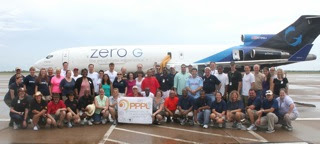By Patti Wieser
So gravity really does cause bubbles to burst.
That’s what one teacher-researcher concluded today after our first group of teachers, team leaders, and staff — about 10 under the PPPL banner — conducted various experiments aboard NASA’s Weightless Wonder.
Teacher Pat Hillyer, a member of the PPPL Space Cowboys team, said a few minutes before boarding, “We are going to try to prove that bubbles pop because of gravity.”
Hillyer, along with Susan Franko and Nick Guilbert, donned cowboy hats and green NASA jumpsuits to conduct their experiments, “Surface Tension of Bubbles in Zero-G, 1-G, and 2-G” and “Oscillations in Microgravity” during a 90-minute flight with 32 parabolas. Data analysis and additional experiments need to be conducted before the bubble breaking results are confirmed.
The three cowboys, along with PPPL’ers Adam Cohen, Kathleen Lukazik, and Aliya Merali, were among a couple of dozen teacher-researchers and NASA staff on the flight that departed at 10:30 a.m.
Before takeoff, they listened to Ball in the House, an a cappella group, while relaxing in the hangar. “I’m not nervous,” said Hillyer, who has been involved in several summer teacher programs at PPPL and was thrilled with the microgravity week opportunity. “PPPL has given me a hand up, not a handout,” she said.
Guilbert and Franko said they were excited, but calm, too. “I’m looking forward to experiencing weightlessness and doing experiments that I would otherwise not be able to do,” Guilbert said. Guilbert, who has run PPPL’s Plasma Camp for high school teachers every summer, teaches at the Peddie School in Hightstown. Franko teaches at the Gregory Elementary School in Trenton. And Hillyer teaches at Matawan-Aberdeen Middle School in Matawan.
The group boarded the aircraft with large blue lettering that read, “Zero-G” and a tagline underneath in gray, “The weightless experience.” The day was hot, sunny, and breezy.
We watched them take off, and then waited inside for their return. A NASA staffer had told them, “This is going to be the time of your life.”
And it was, by the look on the faces of Hillyer and others as they deboarded. Hillyer was the first teacher-researcher to step out. She waved, smiled, and gave hugs to several PPPL’ers.
A short time later, teams members returned to the plane to troubleshoot, remove portions of their experiments, make lists of what they needed to do repairs and replenish, and ready the experiments for tomorrow’s flight.

















































